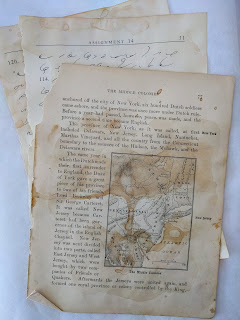I have been beguiled by the journal keeping craze that is everywhere currently. Why not? I love making books and I have all kinds of papers appropriate for journal pages. Now I just need to put something in them...
Here are picture of my process for making a leather bound journal (8.5 x 5 inches) and inserts using things I have in my studio. Enjoy!
Supplies to make a leather journal. (Leather, elastic, inserts, washi tape on acetate sheet)
Some notebooks I already made with different kinds of paper inserts.
Notebook cover with pockets made from Graphic 45 cardstock
Cut the paper to 8.75" x 12". Fold up the bottom part at 8.25 inches. This creates a pocket that is 3.75 inches deep. Cut a V notch in the middle as shown.
I got this piece of 8.5 x 11 inch leather at Michaels. It is the perfect size for this journal.
Cut paper inserts (I used 12 sheets as this Tomoe River Paper is very thin) to 8.25 x 8.25 inches and fold in half with the grain. If you are using thicker paper like watercolor paper you may want to limit it to 8 sheets, which folded in half gives you 32 pages.
Make a template to create sewing holes in the inserts and cover paper. For this project, I measured in 1.25 inches from the top and bottom and made a center hole at 4 1/8 inches. Then I used an awl to poke the holes.
Place the template in the center fold of the pages and poke holes.
Use double stick tape to tape up the sides of the folders in the insert cover.
Pockets are complete.
Put holes in the cover the same way you made them for the pages and cut a piece of waxed linen twice the length of the pages (16.5 inches)
The insert is complete.
To finish the cover you need to make holes in the leather spine using a screw punch. I used a 2.5mm bit and placed three holes at the top and bottom and one hole in the center. The Center hole is located 5.5 inches in from the left and 4 1/8 inches down from the top. The top and bottom holes are 1/4 inch up or down from the edge of the leather and placed at 5, 5.5, and 6 inches from the left edge. This creates a 1 inch spine with plenty of room for 4 inserts.
Screw punch and leather.
I used elastic from the craft store to bind my inserts. Start at the top left hole and come in from the outside of the cover. Leave a tale and run the long end through the adjacent center hole to the right. Then go down to the bottom of the cover and go out through the center hole and into the hole on the right. Go to the top and out the right hole and back through the center hole. Then go down to the bottom of the cover and out the center hole and in the left side hole. Tie the two ends of the elastic together in a square knot. Trim the excess elastic. You will need about 36 inches of elastic for this and you want to pull it taut. It should buckle the leather slightly so that there is some tension when you place the inserts inside.
Use ~14 inches of elastic for the center hole loop that will keep your journal closed. Tie a knot in the ends and insert the loop from the inside to the outside so that the knot is inside the cover.
The finished journal with inserts.
My three handmade journals!


























































